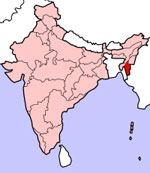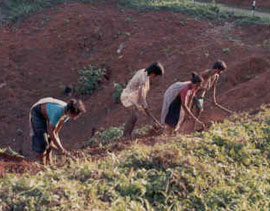Human Flower Project
Saturday, October 29, 2005
Gregarious Flowering
Officials in NE India, fearing that the oncoming bamboo bloom will bring famine, struggle to get a grip on this runaway resource.

Bamboo forest, Mizoram, India
Photo: Bamboo Development Agency
Mizoram, a teardrop hanging between Bangladesh and Myanmar, is wet, hilly land covered with forests. Mizo lore and ag scientists agree there’s a serious threat coming: mautak (Melocanna baccifera ), a widespread species of bamboo, is due to flower, and famine is likely to follow. The disaster after the last great flowering, in 1959-60, killed 3000 people, sparked an armed insurrection, and in fact brought about the creation of Mizoram itself.
“Bamboo flowers ‘gregariously’, as scientists put it: across vast areas. Generally, most species flower at fixed intervals; all clumps including the youngest ones die after flowering, a peculiarity that exists only in bamboo. When a species flowers gregariously, all populations of it raised from the same seed source flower at once, wherever they exist.”
The sudden superabundance of seed nourishes rats, and once the seed supply has been devoured, hungry rodents “run amok, quite literally…. the rats attack granaries, fields of standing crops, paddy, fruits, vegetables, whatever is available.”
After 35 years, mautak has begun blooming again. “In 2002-2003, 34 villages faced an increase in rodent population. In 2003-2004 another 16 witnessed it. 85 villages have already recorded sporadic mautak flowering…. The Union ministry of environment and forests has estimated, in 2005, that 510,000 ha of the mautak-dominant area will flower gregariously.”
 Mizoram (in red)
Mizoram (in red)
Map: Deutsch Wikipedia
If there ever was one, here’s an example of the disastrous consequences of monoculture. Of Mizoram’s total land area, 87% is forested: “51% per cent is under bamboo” and well over half of the bamboo forested area is “completely dominated by the mautak species.”
Within Mizoram, there appears to be a combination of panic, frustration and confusion about the incipient flowering. Modern forest management is coming up against jhum, a form of agriculture centuries old. “For the Mizo people, mautak is an integral ingredient to jhum cultivation, practiced over more than 70 per cent of the land at one or the other time. As Michael Lalmanzuala, a retired chief secretary of Mizoram, explains, ‘In January and February the rural folk begin to fell bamboo for jhum. In March they set fire to the fallen bamboo, turn it to ash. This ash is the best nutrient our steep and young, muddy hills can get for cultivation. Without mautak, cultivators can grow nothing.’ “
A government-sponsored bamboo development agency seems intent on discouraging jhum, finding ways to profit from bamboo harvesting instead, but convincing local farmers to change hasn’t been easy, nor, according to some anthropologists, may it be wise.
 Jhum: Sowing seeds after the winter burn
Jhum: Sowing seeds after the winter burn
Photo: Karbi Culture
This fascinating paper “reappraises” jhum, looking at its practical, ecological and social effects. “At least 100 different indigenous tribes and over 620,000 families in the seven states of North East India depend on jhum for their subsistence.” The paper concludes, “Only occupations providing monetary and social benefits perceived by jhumias to outweigh the cultural and security benefits embodied by jhum are likely to gain acceptance.”
Thus far, those occupations don’t seem to exist. Meanwhile, the mautak has begun its “gregarious” flowering—to peak, botanists say, in 2006.




